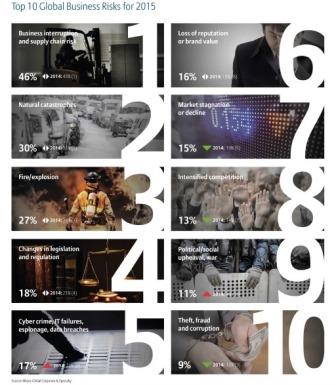An increasingly interconnected corporate environment means rising risk – but what is the greatest threat facing your commercial clients?
According to the fourth
Allianz Risk Barometer 2015, businesses are facing new challenges from a rise of disruptive scenarios.
“The growing interdependency of many industries and processes means businesses are now exposed to an increasing number of disruptive scenarios” says Chris Fischer Hirs, CEO of Allianz Global Corporate & Specialty SE (
AGCS), the dedicated insurer for corporate and special risks of Allianz SE. “Negative effects can quickly multiply. One risk can lead to several others. Natural catastrophes or cyber attacks can cause business interruption not only for one company, but to whole sectors or critical infrastructure.”
Traditional industrial risks such as business interruption and supply chain risk (46 per cent of responses), natural catastrophes (30 per cent), and fire and explosion (27 per cent) continue to concern risk experts, heading this year’s rankings. Cyber (17 per cent) and political risks (11 per cent) are the most significant movers.

“Risk management must reflect this new reality,” says Hirs. “Identifying the impact of any interconnectivity early can mitigate or help prevent losses occurring. It is also essential to foster cross-functional collaboration within companies to tackle modern risks.”
The survey was conducted among more than 500 risk managers and corporate insurance experts from both Allianz and global businesses in 47 countries.
Business risk rankings in North America mirror global risks with business interruption and supply chain risk the top concern for 55 per cent of the responses. Cyber risk, which includes cyber crime, IT failures, espionage and data breaches, was cited as a major business risk by 25 per cent of participants, up from 11 per cent in 2014.
Budget constraints and siloed knowledge impair cyber protection
The risk of cyber crime and IT failures continues its rapid rise in the Allianz Risk Barometer, moving into the top five business risks globally for the first time (in 2014, cyber risks ranked 8th and in 2013 just 15th). In the United States, Germany, and the United Kingdom cyber risks are now among the top three corporate risks. Loss of reputation (61 per cent) and business interruption (49 per cent) are regarded as the main causes of economic loss following an incident. (continued.)
#pb#
Although awareness of cyber risk is increasing, many companies are still underestimating its impact, according to 73 per cent of responses. Budgetary constraints are another reason why companies are not better prepared to combat cyber risks.
“Cyber risks are very complex. Different stakeholders such as IT security architects and business continuity managers need to share their knowledge to identify and evaluate threat scenarios,” says Jens Krickhahn, Practice Leader Cyber & Fidelity at AGCS Financial Lines, Germany & Central Europe. “Previously siloed knowledge needs to be incorporated in one’ think tank’ which can look at risks holistically. The ‘human factor’ should also not be underestimated, as employees can cause IT security incidents, inadvertently and deliberately.”
Political risks on the rise
Political/social upheaval is a much bigger concern for businesses in the 2015 Allianz Risk Barometer, rising nine positions to ninth overall compared with last year’s survey. It is the second top cause of supply chain disruption (53 per cent) after natural catastrophes.

Another source of political tension in 2015 could come from lower oil prices, which may strain the budgets of countries heavily dependent on oil revenues. Combating political risks and terrorism are identified as top business risk management challenges over the next five years.
More severe business interruption implications
For the third year in succession, business interruption (BI) and supply chain risk is the top peril in the Risk Barometer with almost half (46 per cent) of the responses rating this as one of the three most important risks for companies, up 3 per cent year-on-year. Fire/explosion (43 per cent) and natural catastrophes (41 per cent) are the major causes of BI companies fear most.
The impact of the subsequent disruption potentially affecting a company, its suppliers and customers often outweighs the physical damage itself. At $1.36 million (US), the average business interruption insurance claim is already 32 per cent higher than the average direct property damage claim ($1.03 million). (continued.)
“Businesses spend a lot of time assessing direct damage and looking at their own BI impact but more work needs to be done analyzing the risks associated with suppliers and customers,” says Paul Carter, Global Head of Risk Consulting at AGCS, adding that supply chain risk management remains a gap in many multinational companies’ risk management programs, and that many businesses still do not have alternate suppliers.
Regional trends: Talent shortage fears increasing
Although the top three risks BI /supply chain, natural catastrophes and fire and explosion are identical across the Europe, Middle East and Africa (EMEA), Americas and Asia Pacific regions for the third successive year, there are regional differences.
Cyber risk is a big mover in EMEA’s and Americas’ top 10 risks, but it does not appear in the top 10 Asia Pacific risks, suggesting many companies are not grasping the full impact of the potential risks involved. A combination of shortage of skilled talent, together with an aging workforce is deemed an increasing concern and a new entry in the top 10 risks in the U.S.
Industry trends: Competition worries shipping, regulation concerns financial services
The impact of natural catastrophes (42 per cent) such as earthquakes remains the top risk for the Engineering and Construction sector. BI (68 per cent) continues to be the top risk with manufacturers even more concerned than 12 months ago (60 per cent), driven by the potential for large claims in certain sectors such as semiconductor or automotive is increasing.
Changes in legislation and regulation (33 per cent) remain the top concern for financial services, reflecting increasing supervisory intervention around the globe. The shipping sector is concerned about intensified competition (29 per cent), while theft (47 per cent) worries the transportation industry.
Dual challenge: climate change and disruptive technologies
Climate change and natural catastrophes and so-called “disruptive technologies” such as 3D-printing or nanotechnology dominate the long-term risk agenda.
“Companies can expect to face further disruption from technological innovation, while also being exposed to climate change impact as an underlying risk which is not within their direct control”, says Axel Theis, Member of the Board of Management, Allianz SE. “Individual best practice, along with collaboration across companies, industries and regions can help mitigate environmental damage and create future safety, growth and innovation in a more sustainable world.”



